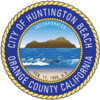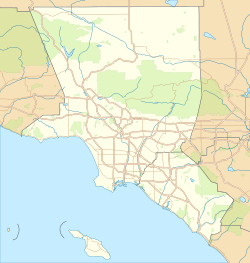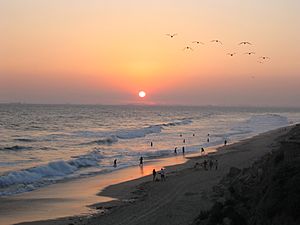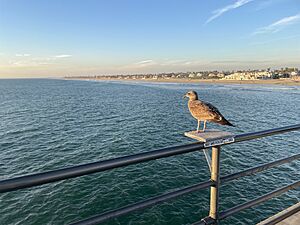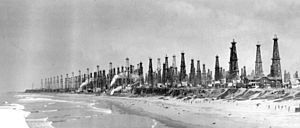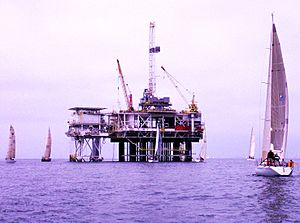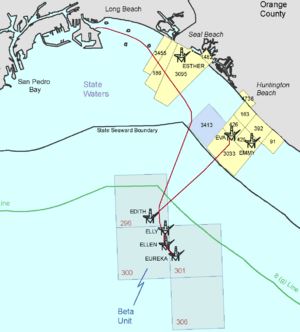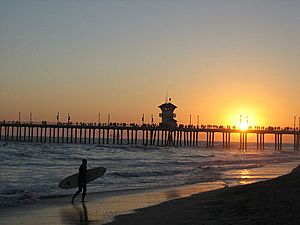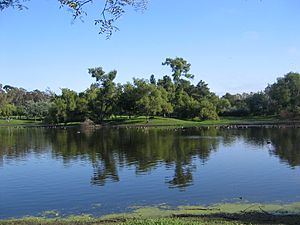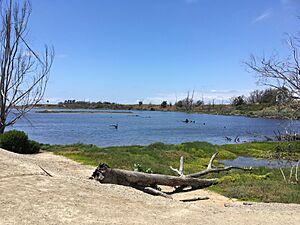Huntington Beach, California facts for kids
Quick facts for kids
Huntington Beach, California
|
|||
|---|---|---|---|
|
Clockwise: the Huntington Beach Pier; Huntington Beach High School; aerial view of the coast; Sunset Beach and Huntington Harbour; downtown
|
|||
|
|||
| Nickname(s):
Surf City
|
|||
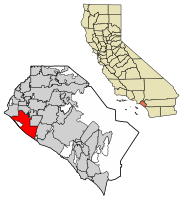
Location of Huntington Beach in Orange County, California
|
|||
| Country | United States | ||
| State | California | ||
| County | Orange | ||
| Incorporated | February 17, 1909 | ||
| Named for | Henry E. Huntington | ||
| Government | |||
| • Type | City Council/City Manager | ||
| Area | |||
| • Total | 28.33 sq mi (73.38 km2) | ||
| • Land | 27.00 sq mi (69.92 km2) | ||
| • Water | 1.33 sq mi (3.46 km2) 16.10% | ||
| Elevation | 39 ft (12 m) | ||
| Population
(2020)
|
|||
| • Total | 198,711 | ||
| • Rank | 4th in Orange County 23rd in California 133rd in the United States |
||
| • Density | 7,014.2/sq mi (2,707.97/km2) | ||
| Time zone | UTC−8 (Pacific) | ||
| • Summer (DST) | UTC−7 (PDT) | ||
| ZIP Codes |
92605, 92615, 92646–92649
|
||
| Area codes | 562, 657/714 | ||
| FIPS code | 06-36000 | ||
| GNIS feature IDs | 1652724, 2410811 | ||
Huntington Beach is a city by the ocean in Orange County, Southern California, United States. It's often called "Surf City" because of its amazing waves. The city is named after Henry E. Huntington, a famous American businessman.
In 2020, about 198,711 people lived here. This makes it the fourth biggest city in Orange County. Huntington Beach is also the largest beach city in Orange County. It is located about 35 miles (56 km) southeast of Downtown Los Angeles. The city has a long 9.5-mile (15.3 km) stretch of sandy beach. It also has a mild climate and a strong beach culture.
Contents
History of Huntington Beach
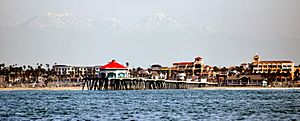
Long ago, the Tongva people lived in this area. Their village, Lupukngna, was near where the Newland House Museum is today.
The main road in Huntington Beach, Beach Boulevard, used to be a path for cattle. Over time, the city had many different names. It was called Shell Beach, Smeltzer, and even Gospel Swamp. Later, it became Fairview and then Pacific City.
To get a train line to the city, Pacific City gave a lot of power to railroad owner Henry E. Huntington. Because of this, the city was renamed after him.
The first Huntington Beach Pier was built in 1904. It was a wooden structure about 1,000 feet (300 m) long. Huntington Beach officially became a city on February 17, 1909. Ed Manning was its first mayor.
The Huntington Beach Company helped develop the city. This company still owns much of the land and mineral rights. It is now owned by the Chevron Corporation.
Years ago, an encyclopedia company gave away free land in Huntington Beach. People who bought a full set of encyclopedias got a plot of land. Later, oil was found in the area! This led to a lot of oil drilling. Even today, you can still see oil pumps around the city.
In its early years, Huntington Beach was mostly farmland. Farmers grew crops like lima beans, asparagus, and sugar beets. Holly Sugar had a big processing plant here.
The city's first high school, Huntington Beach High School, opened in 1906. Its sports teams are called the Oilers, named after the city's oil history.
Geography and Climate
Huntington Beach covers about 31.9 square miles (82.6 km2). Most of this is land, but about 5.1 square miles (13.2 km2) is water.
The city has a mild climate. It's usually sunny, dry, and cool. Strong breezes often blow in the mornings and evenings. Ocean water temperatures are usually between 55 to 65 °F (13 to 18 °C). In summer, temperatures rarely go above 85 °F (29 °C). In winter, they rarely drop below 40 °F (4 °C).
The city gets about 14 inches (360 mm) of rain each year. Most of this rain falls in the middle of winter. Sometimes, a "marine layer" causes cloudy and foggy weather in May and June.
Natural Wonders
Between Downtown Huntington Beach and Huntington Harbour is a large wetland. Much of this area is protected as the Bolsa Chica Ecological Reserve. This reserve is a great place for watching birds and taking photos.
South of Downtown, the Talbert, Brookhurst, and Magnolia Marshes were restored in 2010. These marshes are across from Huntington State Beach.
The northern and southern beaches are state parks. Bolsa Chica State Beach and Huntington State Beach are managed by the state. The city manages the central beach, Huntington City Beach. You can camp and park RVs here.
The Sunset Marina Park is next to Huntington Harbour. It's part of Anaheim Bay. This park is good for small boats and has a marina and picnic areas.
People of Huntington Beach
| Historical population | |||
|---|---|---|---|
| Census | Pop. | %± | |
| 1930 | 3,690 | — | |
| 1940 | 3,738 | 1.3% | |
| 1950 | 5,237 | 40.1% | |
| 1960 | 11,492 | 119.4% | |
| 1970 | 115,960 | 909.0% | |
| 1980 | 170,505 | 47.0% | |
| 1990 | 181,519 | 6.5% | |
| 2000 | 189,594 | 4.4% | |
| 2010 | 189,992 | 0.2% | |
| 2020 | 198,711 | 4.6% | |
| U.S. Decennial Census | |||
In 2020, Huntington Beach had a population of 198,711 people. Most residents were White (63.7%). About 13.2% were Asian, and 19.9% were Hispanic or Latino.
There were about 74,285 homes in the city in 2010. About 29.5% of these homes had children under 18. The average household had 2.55 people.
Economy and Jobs
Huntington Beach is built over a large natural oil field. This means there's a lot of oil underground. The city also has pipelines that bring oil from offshore and from a refinery in Santa Fe Springs.
Oil and the Environment
On October 3, 2021, an oil spill happened off the coast. Over 120,000 gallons of oil leaked from an offshore platform. The oil reached the beaches and wetlands, causing damage to the environment. Birds and fish were found dead. Officials worked to clean up the spill and protect the sensitive wetlands.
Shopping and Businesses
Downtown Huntington Beach has an art center, shops, and restaurants. The International Surfing Museum is also located here.
The Huntington Beach Pier stretches out into the Pacific Ocean. A restaurant called Ruby's Diner was at the end of the pier for many years. Now, Broad Street Oyster Company is there.
Other shopping areas include Bella Terra, Pacific City, and Old World Village. Old World Village has a German theme.
Several hotels are built near the beach, close to the pier. Huntington Beach also has a small industrial area. A major Boeing facility is located here. It used to make parts for the Apollo Program rockets.
"Surf City USA" Trademark
Huntington Beach is known as "Surf City USA." The city's tourism group registered this name as a trademark in 2004. This helps promote the city's beach culture and outdoor lifestyle. They also sell products with the "Surf City USA" brand.
The city had a disagreement with Santa Cruz, California over the "Surf City" name. They reached an agreement in 2008, allowing Huntington Beach to keep the trademark.
Top Employers
Many people work in Huntington Beach. Here are some of the top private employers:
| # | Employer | # of employees |
|---|---|---|
| 1 | Boeing | 3,112 |
| 2 | Cambro Manufacturing | 650 |
| 3 | Hyatt Regency Huntington Beach | 641 |
| 4 | Safran Cabin Inc. | 633 |
| 5 | Boardriders Wholesale | 574 |
| 6 | Huntington Beach Hospital | 527 |
| 7 | Walmart Inc. | 462 |
| 8 | No Ordinary Moments | 458 |
| 9 | Hilton Waterfront Beach Resort | 450 |
| 10 | The Home Depot | 436 |
Arts and Culture
Special Events
Many fun events happen in Huntington Beach, especially on the beach during summer. The U.S. Open of Surfing is a big event held near the pier. The city also hosts beach volleyball tournaments.
The Fourth of July parade has been a tradition since 1904. The Huntington Beach Film Festival takes place every February.
The Pacific Airshow is held each October. It features amazing air shows with jet teams.
In winter, the Cruise of Lights Boat Tour lights up Huntington Harbour. Boats decorated with colorful lights parade through the water.
The Surf City USA marathon happens every February. The annual Kite Festival is held near the pier in late February.
Huntington Beach also has car shows. The Beachcruiser Meet in March shows off classic cars. An informal "Donut Derelicts" car show happens every Saturday morning.
Surf City Nights is a community event held every Tuesday night. It includes a farmer's market, entertainment, and food.
Sports and Recreation
Huntington Beach is famous for surfing. It hosts world surfing championships every summer. The city is called "Surf City" because of its consistent, good quality waves.
Surfing and Beaches
George Freeth was the first person to surf in Huntington Beach in 1914. Duke Kahanamoku also helped make surfing popular here starting in 1925. The first surfboard shop opened under the Huntington Beach Pier in 1956.
Huntington Beach has great surf spots. The beaches face different directions, which affects the waves.
- Bolsa Chica State Beach is long and narrow. It's best for surfing with longboards.
- "The Cliffs" or "Dog Beach" is a popular surf spot where dogs are allowed.
- Huntington City Beach (near the pier) is great for shortboarding.
- Huntington State Beach is wide and gets strong south swells. It's best for shortboarding, especially in summer and fall.
Huntington Beach is also a popular place for kite surfing. You can see this sport northwest of the pier.
Bicycling
The Huntington Beach bicycle path runs for 10 miles (16 km) along the beach. You can rent different types of bicycles here.
Kayaking and Paddleboarding
Kayaking and standup paddleboarding are popular in Huntington Harbour. You can rent kayaks and paddleboards to explore the harbor.
Golf
Huntington Beach has three golf courses:
- Meadowlark Golf Club is an 18-hole course.
- Huntington Beach Disc Golf Course is an 18-hole disc golf course in Central Park West.
- The Huntington Club is a private country club with an 18-hole golf course.
Parks and Fun Places
Central Park
Huntington Central Park is the largest city park in Orange County. It covers almost 350 acres (140 ha). The park has plants that don't need much water and is home to local wildlife.
The Huntington Beach Public Library is located in Central Park. It has many books, a theater, and fountains. The library was founded in 1914.
The park also has the Huntington Central Park Equestrian Center. This is a large facility for horses. You can even rent horses for guided trail rides through the park.
There's also an Adventure Playground, or mud pit, for kids. It's a unique playground that opened in 1974.
The world's second oldest disc golf course is in the park. There are also dining areas, a sports complex, and the Shipley Nature Center.
Bolsa Chica Ecological Reserve
The Bolsa Chica State Ecological Reserve is a natural wetland area. It's over 1,200 acres (4.9 km2) and has many walking trails. It's a top spot for birdwatching in the U.S. Many birds stop here during their migration.
Huntington Dog Beach
Huntington Dog Beach is a special area where dogs are allowed on the beach. It's about 1.5 miles (2.4 km) long. Many events for dogs happen here, like Surf City Surf Dog.
The Preservation Society of Huntington Dog Beach helps keep the beach clean and safe. They provide free waste bags for dogs and organize beach cleanups. They also share tips for dog owners. Dogs must be on a leash when entering and leaving the park.
Education in Huntington Beach
Public Schools
Huntington Beach is home to Golden West College. This college offers two-year degrees and helps students transfer to four-year universities.
The city is part of the Huntington Beach Union High School District. This district includes:
- Edison High School
- Huntington Beach High School
- Marina High School
- Ocean View High School
There are also several elementary school districts in the city.
Private Schools
- Grace Lutheran School (K–8)
- Huntington Christian School (K–8)
- The Pegasus School (a recognized "blue ribbon school")
Public Libraries
Huntington Beach has five public libraries:
- Central Library
- Main Street Branch Library
- Banning Branch Library
- Helen Murphy Branch Library
- Oak View Branch Library
Media and Entertainment
Huntington Beach has been featured in TV shows and songs. The Beach Boys mention the city in their song "Surfin' Safari".
Live cameras are set up at the Huntington Beach Pier. These cameras show views of the pier on screens in Hollister clothing stores. The money from this helps fund marine safety equipment.
The public TV station KOCE-TV operates from the Golden West College campus.
Getting Around Huntington Beach
Huntington Beach has many public streets. Interstate 405 (I-405) runs through the northeastern part of the city.
Bus service is available through the OCTA. Most homes in Huntington Beach have at least one car.
Safety and Emergency Services
The Huntington Beach Fire Department provides fire protection. The Huntington Beach Police Department handles law enforcement.
Huntington Beach Marine Safety Officers and lifeguards are known for being excellent. They help with water rescues and first aid. The city also has a program to train citizens for emergencies.
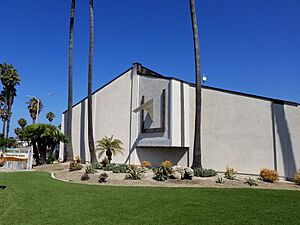
Since it's a city by the sea, Huntington Beach has faced challenges like storm surges and oil spills. The Huntington Beach Pier has been rebuilt several times to withstand storms and earthquakes.
Some areas of the city are in soil liquefaction zones, which means the ground could become unstable during an earthquake.
Sister Cities
Huntington Beach has special relationships with cities in other countries:
 Anjo, Aichi Prefecture, Japan
Anjo, Aichi Prefecture, Japan Manly, New South Wales, Australia (unofficial)
Manly, New South Wales, Australia (unofficial)
See also
 In Spanish: Huntington Beach para niños
In Spanish: Huntington Beach para niños








